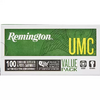Styx
Member
- Joined
- Dec 11, 2014
- Messages
- 3,284

I simply buy the most affordable ammunition available that will penetrate and expand to generally acceptable rates and call it a day. If I can find it it's a box of 50 or 100 Remington UMC. I'll leave everyone else to over analyze, obsess over, and bicker about calibers and different loads.


I also carry Federal Syntech which I was able to pick up several boxes on 20 each from Wally World back in the day @ $6 and change per box.
IMHO these micro analysis on caliber and load debates are silly and borderline obsessive compulsive thing gun nuts do that's a waste of time. Freaking buy something affordable that's consistent and train and/or practice with it. It's that simple. I rather have 100 rounds of UMC than a lot less of some super self defense ammo that's a lot more expensive thus I won't shoot it as much. I rather shoot a caliber that I can shoot well and handle the recoil whether it be 22mag or not than to carry something more powerful just because know it all experts on the inet tell me I'm doing it wrong. If the round hits and has enough energy to penetrate then it's enough. Most common self defense ammo is enough to get to vitals if the shot placement is on point.
It's not as complicated as a minority over super obsessed gun owners make it out to be. K.I.S.S.
Last edited:

